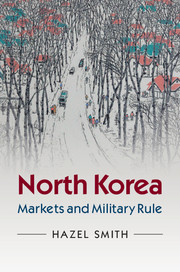Book contents
- Frontmatter
- Dedication
- Contents
- Acknowledgements
- Introduction: North Korea: politics, economy and society
- Part I Jettisoning caricatures: understanding history
- Part II The rise and fall of Kim Il Sungism
- 3 Colonial occupation and the rise of Kim Il Sung
- 4 War-fighting as state-building
- 5 ‘Socialism in our own style'
- 6 Sisyphus as economic model
- 7 Social stratification in the workers' state
- 8 Famine and the end of Kim Il Sungism
- Part III Marketisation and military rule
- Bibliography
- Index
4 - War-fighting as state-building
from Part II - The rise and fall of Kim Il Sungism
Published online by Cambridge University Press: 05 May 2015
- Frontmatter
- Dedication
- Contents
- Acknowledgements
- Introduction: North Korea: politics, economy and society
- Part I Jettisoning caricatures: understanding history
- Part II The rise and fall of Kim Il Sungism
- 3 Colonial occupation and the rise of Kim Il Sung
- 4 War-fighting as state-building
- 5 ‘Socialism in our own style'
- 6 Sisyphus as economic model
- 7 Social stratification in the workers' state
- 8 Famine and the end of Kim Il Sungism
- Part III Marketisation and military rule
- Bibliography
- Index
Summary
In June 1950 the two Koreas went to war against each other to re-unify Korea. Kim Il Sung's aim was to rid the peninsula of United States troops and establish a communist, Kim Il Sung-led polity throughout the Korean peninsula. The aim of the President of South Korea, Synghman Rhee, was to unite Korea under southern leadership. China sent over a million troops and the Soviet Union provided military assistance to Kim Il Sung, while a United States-led United Nations coalition fought on the side of South Korea. Both Koreas suffered terrible physical devastation and millions died while the North suffered disproportionate loss of life and physical damage due to the bombing campaigns that targeted economic and military infrastructure, and that continued throughout the war. In July 1953 when the war ended, neither side had achieved wartime objectives. North Korea and South Korea remained politically divided in more or less the same territories that each had governed prior to the war.
Kim Il Sung used the excuse of the exigencies of war to build political, economic and social systems and structures whose function was to secure Kim's personal power and to carry out his directives in every sector of politics, economy and society. Opposition figures were purged and alternative perspectives eradicated. Kim built a mass Party whose job was to function as a transmission belt for the leader's directions and as a mechanism of control over the population. Kim institutionalised the policy and practice of ‘anti-bureaucratism' with the aim of preventing the opportunity for alternative political platforms or perspectives to have space to develop within the Party, the workplace and the society at large. Kim expanded mass mobilisation policies so that all of society was expected to participate in Kim-led, hierarchically organised support activities for the war effort. These organisational practices were dependent on and underpinned by the hard physical labour of the population.
- Type
- Chapter
- Information
- North KoreaMarkets and Military Rule, pp. 91 - 109Publisher: Cambridge University PressPrint publication year: 2015



